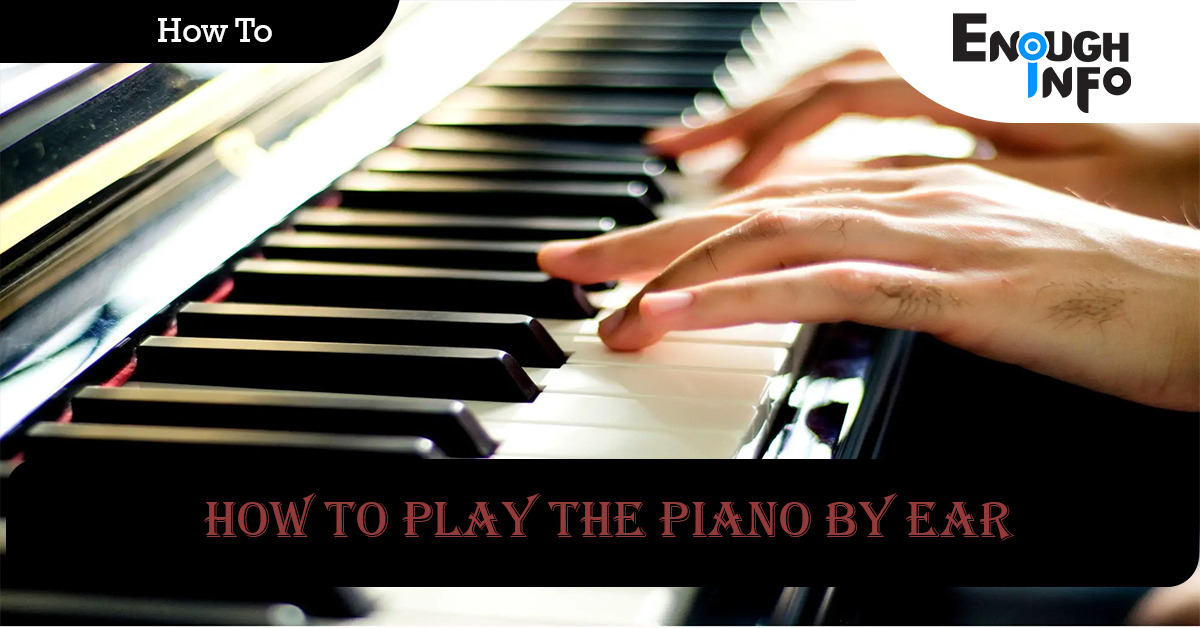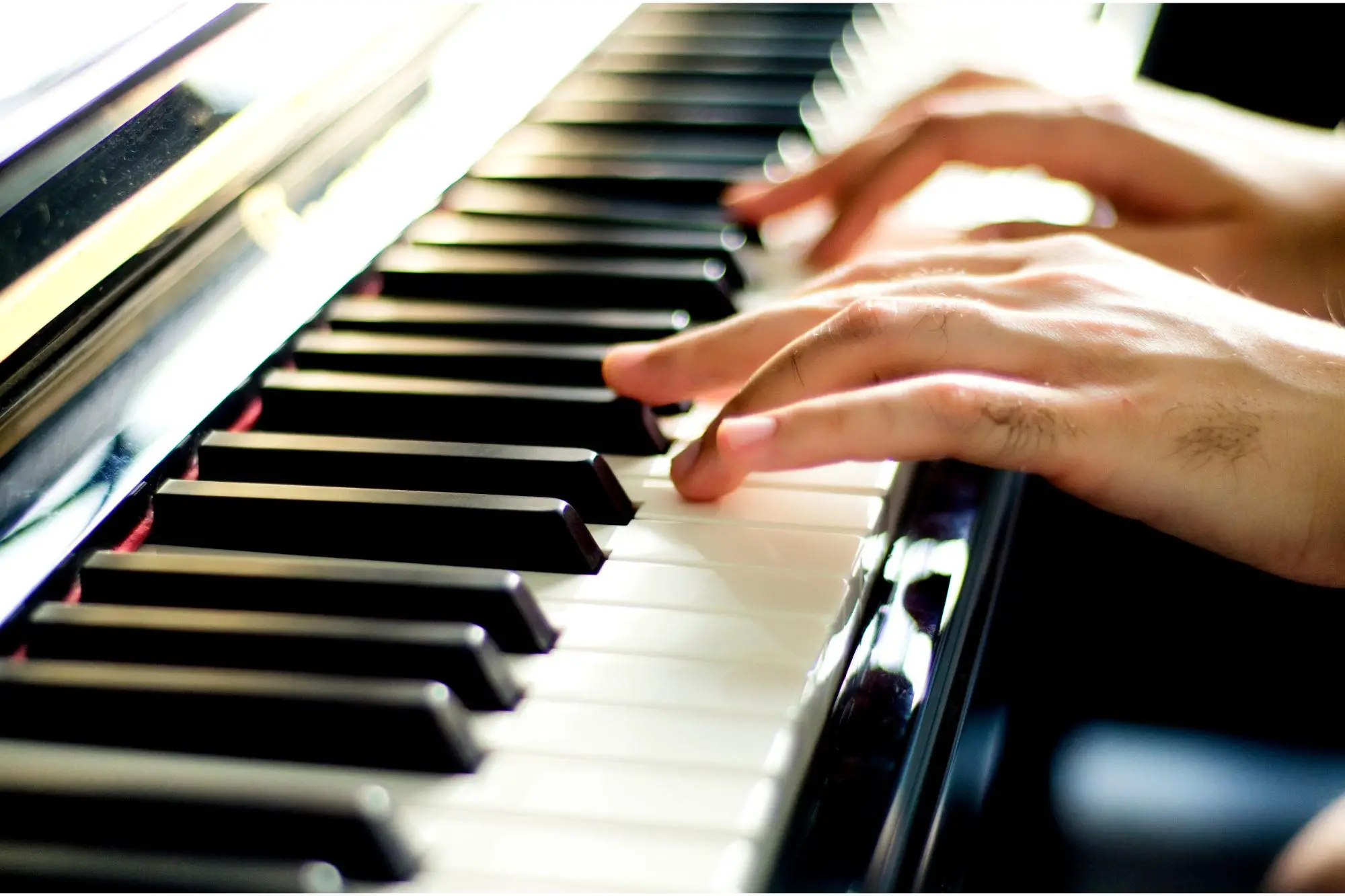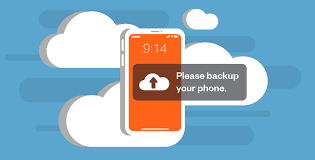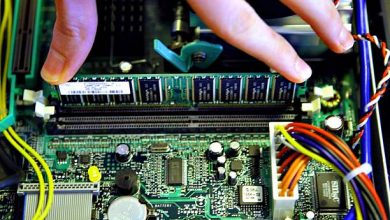How to play the piano by ear(step-by-step guide)

How to play the piano by ear – Playing the piano by ear is a skill that allows musicians to explore their creativity and express themselves in a unique way. While reading sheet music is valuable, learning to play by ear opens up a world of possibilities and enables you to play your favorite songs, improvise, and develop a deeper connection with the instrument.

There are two techniques to learning the piano: Learning to read sheet music or “playing by ear.” While both ways have advantages, playing by ear is considered to be the more difficult of the two.
After all, reading music is a talent that can be mastered quickly, yet developing a strong ear for music can take years. Playing by ear, on the other hand, is a profoundly satisfying experience that allows pianists to connect with the music on a deeper level. Furthermore, many of the world’s finest pianists began their musical careers by learning to play by ear. EnoughInfo.com
In this article, we will guide you through the process of playing the piano by ear, helping you unlock the melodies within you. How to make a homemade face mask
Is it possible to learn to play the piano by ear?
The ability to play the piano by ear is frequently seen as a gift bestowed upon a select few. However, there is evidence that suggests that with the correct guidance, anyone can learn to play the piano by ear.
The findings show that anyone, with the right coaching and effort, can learn to play the piano by ear. How To Emotionally Connect With A Taurus Man
With this in mind, it appears that anyone interested in learning to play piano by ear should not be disheartened – with some attention and effort, this skill may be developed.
Unlocking the Melodies: A Guide to Playing the Piano by Ear
Develop Your Musical Ear:
Playing the piano by ear starts with developing your musical ear. This involves training your ears to recognize and reproduce melodies, chords, and harmonies. Here are some ways to enhance your musical ear:
Read Also: 185+ Deep Love Messages For Her (Melt Her Heart)
Listen actively to music:
Engage with different genres of music and pay attention to the melodies, chords, and rhythms. Focus on identifying patterns and musical elements within the songs.
Sing along: Singing along with melodies helps internalize the musical structure and intervals. This practice strengthens your ability to recognize and reproduce pitch.
Play simple melodies:
Begin by playing simple melodies on the piano and try to recreate them by ear. Start with nursery rhymes or familiar tunes that you can easily recall.
Understand Music Theory Basics:
While playing by ear doesn’t require extensive knowledge of music theory, having a basic understanding of chords, scales, and intervals will greatly assist you in identifying and recreating melodies. Familiarize yourself with the major and minor scales, common chord progressions, and intervals between notes.
Break Down Songs:
When learning a song by ear, it’s helpful to break it down into smaller sections. Listen to the song carefully and identify the main melody or the bass line. Play along with the recording and try to replicate what you hear. It’s important to start with simpler songs and gradually progress to more complex pieces as your skills develop.
Analyze Chord Progressions:
Once you can identify the melody, focus on the underlying chord progressions. Listen for the harmonies and try to determine the chords being played. Recognizing common chord progressions, such as the I-IV-V progression in many popular songs, will give you a strong foundation for playing by ear. How to Train a Puppy to Sit (Step-by-Step Guide)
Practice Transcribing:
Transcribing involves listening to a piece of music and notating the melody, chords, and other musical elements. This practice helps refine your ear and transcription skills. Start by transcribing short melodies or chord progressions and gradually work your way up to transcribing entire songs.
Experiment and Improvise:
Playing by ear gives you the freedom to experiment and improvise on the piano. Once you have a good grasp of playing by ear, explore different chord progressions, embellishments, and variations on melodies. This allows you to add your own personal touch to the music and develop your improvisational skills.
Read Also: 22 Top Foods For Promoting Heart Health(All You Need to Know)
Seek Resources and Guidance:
There are numerous resources available to assist you in learning to play the piano by ear. Online tutorials, ear training apps, and books dedicated to playing by ear can provide valuable guidance and exercises. Additionally, seeking guidance from a piano teacher or mentor who specializes in playing by ear can offer personalized support and feedback.
Remember, learning to play the piano by ear is a journey that requires patience, practice, and perseverance. It may take time to develop your musical ear and become comfortable with playing without sheet music. Embrace the process and enjoy the freedom and creativity that playing by ear brings. Let your ears guide your fingers, and let the melodies within you come to life on the piano.
Use Chord Progression Resources:
To enhance your ability to play by ear, make use of chord progression resources. There are websites, apps, and books that provide common chord progressions for various genres of music. These resources can serve as a valuable reference when trying to identify and recreate chord progressions in songs. https://enoughinfo.com/how-to-play-the-piano-by-ear/
Practice with Accompaniment Tracks:
Playing along with accompaniment tracks can be a helpful tool in training your ear and playing by ear. Look for backing tracks or karaoke versions of songs that you enjoy. Play the melody or chords alongside the track and try to match the timing, rhythm, and dynamics of the original recording. This will improve your ability to listen and respond to other musical elements while playing by ear.
Embrace the Power of Repetition:
Repetition is key when learning to play by ear. As you listen to a song repeatedly, you’ll become more familiar with its melodies, chord progressions, and intricacies. Take the time to break down and analyze specific sections of the song that you find challenging. Practice those sections repeatedly until you can play them accurately. Over time, your ability to play by ear will improve, and you’ll become more efficient in recognizing and reproducing musical elements.
Trust Your Musical Instincts:
Playing the piano by ear requires trust in your musical instincts. Sometimes, the exact notes or chords played in a song may be difficult to discern. In such cases, rely on your knowledge of music theory, your ear, and your intuition to make educated guesses. Trust that your understanding of melodies, scales, and chord progressions will guide you in creating a version that sounds pleasing to your ears. How To Paint A Sunset With Acrylics(The Ultimate Guide)
Stay Patient and Persistent:
Learning to play the piano by ear is a skill that takes time and dedication to develop. Be patient with yourself and celebrate small victories along the way. It’s normal to encounter challenges and moments of frustration, but persist in your practice and keep pushing yourself to improve. With consistent effort and a positive mindset, you’ll gradually become more proficient at playing the piano by ear. https://enoughinfo.com/how-to-play-the-piano-by-ear/
Playing the piano by ear is a valuable skill that allows for greater musical freedom and creativity. It enables you to explore different genres, play your favorite songs, and improvise with confidence. By developing your musical ear, understanding basic music theory, and engaging in regular practice, you’ll unlock a whole new world of musical expression. Embrace the joy of playing by ear and let your intuition guide you as you create beautiful melodies on the piano.
Experiment with Different Styles and Genres:
As you become more comfortable playing the piano by ear, don’t be afraid to explore different styles and genres of music. Whether it’s jazz, classical, pop, or blues, each genre offers its own unique melodies, harmonies, and chord progressions. Challenge yourself to learn songs from various genres, as this will broaden your musical vocabulary and enhance your overall playing ability.
Collaborate with Other Musicians:
Playing the piano by ear can be even more enjoyable when you collaborate with other musicians. Joining a band, participating in jam sessions, or simply playing alongside friends who play different instruments can greatly enhance your musical experience. It allows you to listen and respond to other musicians in real time, further developing your ability to play by ear and improvise.
Record and Analyze Your Playing:
Recording yourself while playing the piano by ear can be a valuable practice. By listening to your recordings, you can evaluate your accuracy, timing, and interpretation. It also gives you an opportunity to identify areas for improvement and fine-tune your playing. Additionally, comparing your recordings to the original songs can help you refine your ear and strive for greater accuracy.
Attend Workshops and Masterclasses:
Consider attending workshops or masterclasses focused on playing the piano by ear. These events often feature experienced musicians who can provide valuable insights, tips, and techniques. It’s an opportunity to learn from professionals and interact with other like-minded musicians, fostering growth and inspiration in your musical journey.
Read Also: How To Make Money Without A Job (30 Authentic Ways)
Maintain a Balanced Approach:
While playing the piano by ear is a wonderful skill, it’s important to maintain a balanced approach to your musical development. Incorporate sheet music reading, music theory, and technical exercises into your practice routine. This well-rounded approach will strengthen your overall musicality and expand your repertoire.
Enjoy the Process:
Above all, remember to enjoy the process of playing the piano by ear. It’s a creative and expressive way to connect with music and develop your own unique style. Embrace the moments of discovery, the challenges, and the joy that comes from creating beautiful music without the constraints of sheet music. Allow yourself the freedom to explore, experiment, and find your own musical voice.
Playing the piano by ear is a journey of self-expression and musical exploration. With time, practice, and a genuine love for music, you’ll develop the ability to listen deeply, analyze, and play melodies and chords effortlessly. Embrace the beauty of playing by ear and let your passion for music guide you as you unlock the full potential of the piano.
Expand Your Repertoire:
As you gain confidence in playing the piano by ear, challenge yourself to expand your repertoire. Explore a wide range of songs and genres, including both popular tunes and lesser-known tracks. This will not only broaden your musical horizons but also expose you to different melodies, chord progressions, and styles of playing. The more diverse your repertoire, the more versatile and adaptable you’ll become as a pianist. How to plant tomatoes in pots(The Ultimate Guide)
Improvise and Create Your Own Music:
One of the joys of playing the piano by ear is the ability to improvise and create your own music. Once you have a good grasp of playing melodies and chords by ear, allow yourself the freedom to experiment with different musical ideas. Explore various scales, rhythms, and chord progressions to compose your own original pieces. This creative process will not only enhance your playing skills but also provide a unique outlet for self-expression.
Seek Inspiration from Other Musicians:
To further develop your skills and musicality, seek inspiration from other musicians who excel at playing the piano by ear. Watch live performances, listen to recordings, and study the techniques of accomplished pianists known for their ability to play by ear. Absorb their musicality, phrasing, and improvisational skills, and incorporate elements that resonate with you into your own playing.
Practice with Different Instruments:
Playing the piano by ear doesn’t mean you have to limit yourself to the piano alone. Experiment with other instruments, such as guitar or keyboard synthesizers, to further enhance your understanding of melodies, harmonies, and chord progressions. Playing different instruments will expand your musical perspective and give you a deeper appreciation for the interplay between different musical elements.
Embrace Challenges and Push Your Limits:
To continue growing as a pianist who plays by ear, embrace challenges, and push yourself beyond your comfort zone. Take on more complex songs, tackle intricate melodies, and explore challenging chord progressions. With each new challenge, you’ll sharpen your listening skills and expand your musical abilities. Remember, it’s through overcoming obstacles that we truly grow and reach new heights in our musical journey.
Share Your Music with Others:
Playing the piano by ear is meant to be shared and enjoyed with others. Whether it’s performing for friends and family, participating in open mic nights, or collaborating with other musicians, sharing your music will not only inspire others but also provide valuable feedback and opportunities for growth. Embrace the joy of performing and let your passion for playing by ear resonate with others.
Never Stop Learning:
Playing the piano by ear is a lifelong learning process. Stay curious and never stop seeking knowledge and new musical experiences. Attend workshops, take lessons, and explore online resources to continue honing your skills and expanding your musical understanding. Remember, the more you invest in your musical education, the richer and more rewarding your journey of playing the piano by ear will be. How to Write a Resume (The Ultimate Guide)
Read Also: How to play guitar chords(All You Need To Know)
FAQs & Answers
1, How long does it take to learn to play the piano by ear?
The time it takes to learn to play the piano by ear varies from person to person. It depends on factors such as prior musical experience, dedication to practice, and individual learning abilities. Some individuals may progress more quickly, while others may take more time. Consistent practice and patience are key to developing this skill.
2, Can play the piano by ear help with improvisation?
Yes, playing the piano by ear is closely tied to improvisation. When you can play by ear, you have a better understanding of melody, harmony, and chord progressions, which are essential for improvisation. Playing by ear allows you to respond intuitively to the music and create your own variations, embellishments, and improvisations.
3, Should I still learn to read sheet music if I want to play by ear?
While reading sheet music is not a requirement for playing the piano by ear, it is still beneficial to learn to read music notation. Reading sheet music helps in understanding the musical structure, rhythm, and complex compositions. It also allows you to access a vast repertoire of music that may not be readily available by ear. Learning both skills—playing by ear and reading sheet music—can make you a more versatile and well-rounded musician.
4, Can I play any song by ear?
With the practice and development of your musical ear, you can learn to play a wide variety of songs by ear. However, keep in mind that some songs may be more challenging than others, especially those with complex melodies or intricate chord progressions. Starting with simpler songs and gradually progressing to more complex pieces will help build your skills and confidence.
4, Is it important to have a good piano or keyboard to play by ear?
While having a good piano or keyboard with quality sound can enhance your playing experience, it is not a prerequisite for playing the piano by ear. As long as your instrument is in decent condition and produces clear and accurate tones, you can develop your ability to play by ear effectively.
Remember, learning to play the piano by ear is a journey, and everyone progresses at their own pace. With consistent practice, a passion for music, and a willingness to explore and experiment, you can develop your skills and unlock the joy of playing the piano by ear.
Conclusion
Playing the piano by ear is a gratifying and empowering skill that allows you to express your musicality and connect with music on a deeper level. By developing your musical ear, expanding your repertoire, embracing challenges, and staying open to learning, you’ll continue to grow as a pianist who can effortlessly bring melodies to life. So, grab your piano, let your ears guide your fingers, and embark on a beautiful journey of playing the piano by ear.




